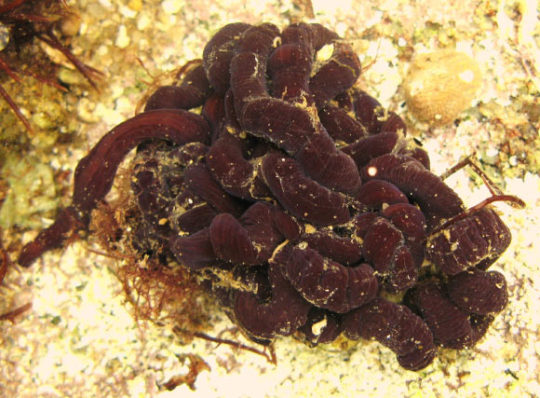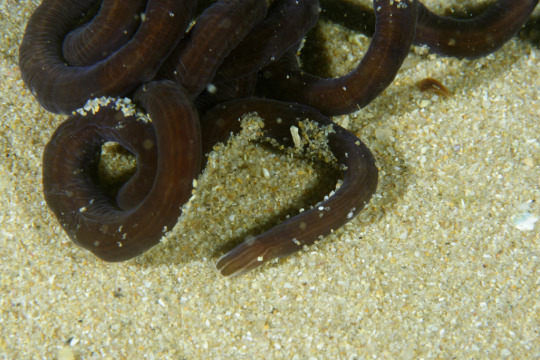#Heteronemertea
Explore tagged Tumblr posts
Text



Lace Up with the Bootlace Worm
Appropriately named, the bootlace worm (Lineus longissimus) is a species of ribbon worm, which are known for their long, slender bodies. The bootlace worm in particular is often credited with being the longest species in this group, and perhaps one of the longest known animals in the world. Though they're only about 5 to 10 mm (0.20 to 0.39 in) around, most bootlace worms can be anywhere from 10 to 15 m (32 to 49 ft) long. Some reports of individuals as long as 30 to 55 m (98 to 180 ft) have been recorded, but few have been confirmed. L. longissimus is relatively uniform in appearence, with a dark purple or brown body and few distinct facial features.
Like most other ribbon worms, the bootlace worm is a marine species. They're most often found along the coasts of northern Europe, especially washed up on beaches or in tide pools. L. longissimus has a fairly basic anatomy; it has no heart or spine, and a simple digestive system. They feed opportunistically on a variety of other invertebrates, including mussels, clams, annelids, and crustaceans, as well as animal carcasses. When a bootlace worm encounters a potential meal, it expels a special feeding structure called the "proboscis" from a special pouch inside its mouth. The force that propels the probiscis towards its prey also turns it inside out. Once they find their prey, the bootlace worm latches on and injects a neurotoxin that paralyses or kills its target. When L. longissimus itself becomes prey, typically by larger crustaceans or fish, it secretes a toxin-filled mucus from its skin that impairs the predators and allows the worm to escape-- much like another worm-like creature, the hagfish.
Little is known about L. longissimus's reproductive biology. The group it belongs to, ribbon worms, are highly variable and have distinct male and female sexes, or individuals can carry the gonads of both. Sexually reproductive ribbon worms often release eggs and sperm into the water, where they fertilize and become microscopic larvae. Ribbon worms, including the bootlace worm, can also split into segments when disturbed; each segment then has the ability to fully regenerate an entire body. The lifespan of the bootlace worm is also unknown, although it's likely only 1-2 years, like most other ribbon worms.
Conservation status: The bootlace worm has not been evaluated by the IUCN. However, as it is primarily found along coasts and in tide pools, populations are likely stable barring extreme habitat disturbance or pollution.
If you like what I do, consider leaving a tip or buying me a ko-fi!
Photos
Cédric Audibert
Sion Roberts
João Pedro Silva via iNaturalist
#bootlace worm#Heteronemertea#Lineidae#ribbon worms#worms#invertebrates#marine fauna#intertidal zone#coasts#atlantic ocean#europe#northern europe
239 notes
·
View notes
Text

King ribbon worm (Notospermus tricuspidatus)
Photo by Arthur Anker
#king ribbon worm#notospermus tricuspidatus#notospermus#lineidae#heteronemertea#nemertea#lophotrochozoa
72 notes
·
View notes
Photo

Ribbon worm (Baseodiscus hemprichii)
Photo by Arthur Anker
#ribbon worm#baseodiscus hemprichii#baseodiscus#valenciniidae#heteronemertea#pilidiophora#nemertea#lophotrochozoa
86 notes
·
View notes